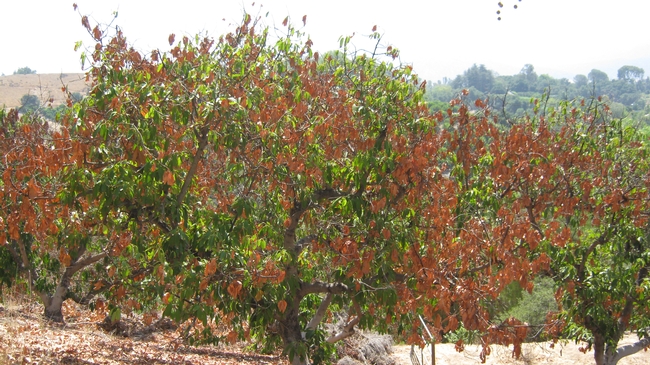A call from a small grower, surprised at the sudden decline of the avocado trees. It must be a disease was the grower's thought. Well driving up to the site, there were numerous trees with canopies indicating drought stress. In fact most of the trees looked like they had had the water turned off. When I got to the orchard, all the trees had a similar look (see photo below). The fringe of the canopy had turned brown/red where the leaves had collapsed rapidly, while the interior leaves were often still green. All the trees had a similar cast. It turns out the water district had required a cutback just when temperatures were going into the 100's. NO water, no cooling effect of transpiration and the outer fringe of leaves collapsed. This is called the “clothesline” effect. It's like a sheet on a clothesline where the margins of the sheet dry first and gradually the body of the sheet dries. The same thing happens in a canopy. The outside leaves are the first to dry out and then the rest of the canopy goes. When you see a whole orchard go down suddenly, that does not fit into a disease pattern. There's usually an epicenter where it starts – where it's colder, wetter, dryer, hotter, more overgrown, etc. and spreads out from there if it is going to spread. It turns out that the automatic irrigation system had gone down and the grower hadn't noticed until too late. When you see reddish tinged leaves, it means the leaves went down fast. When they are brown, it means they slowly went down over weeks or months.
With all the dead points in the tree, it is now open to disease – twig/leaf blight caused by one of the Botryosphaerias. These decay fungi are everywhere in an orchard decaying organic material on the orchard floor. With the dead material in the tree, now the tree becomes a potential feast for the fungi. The dead stuff has to come out, or the fungus will start eating into the tree. I suggested that instead of pruning out all those little points of death, that they cut back the whole canopy to major scaffold branches. In doing so, it would rapidly and cheaply remove the dead material and reduce the water demand.
Attached Images:
